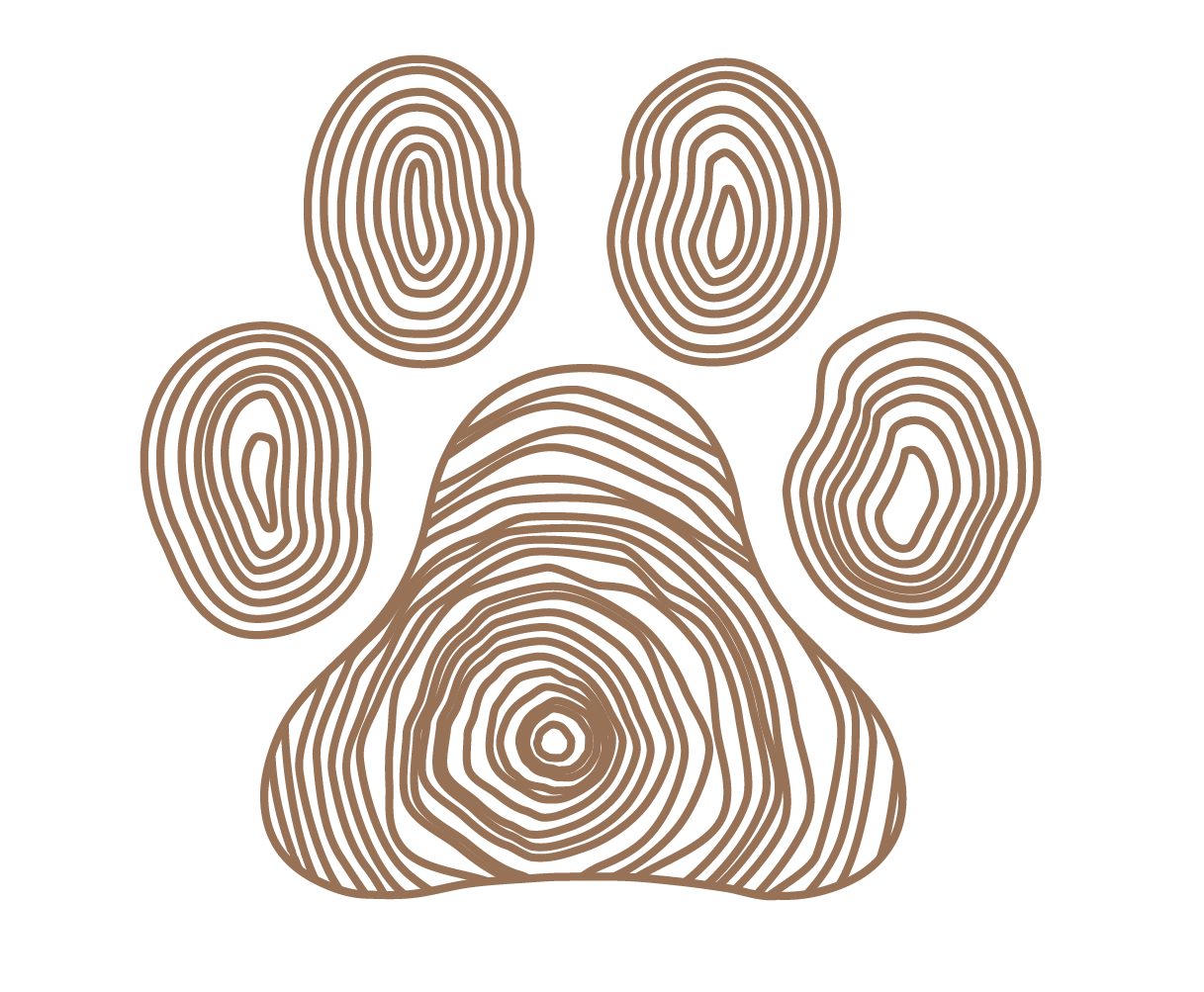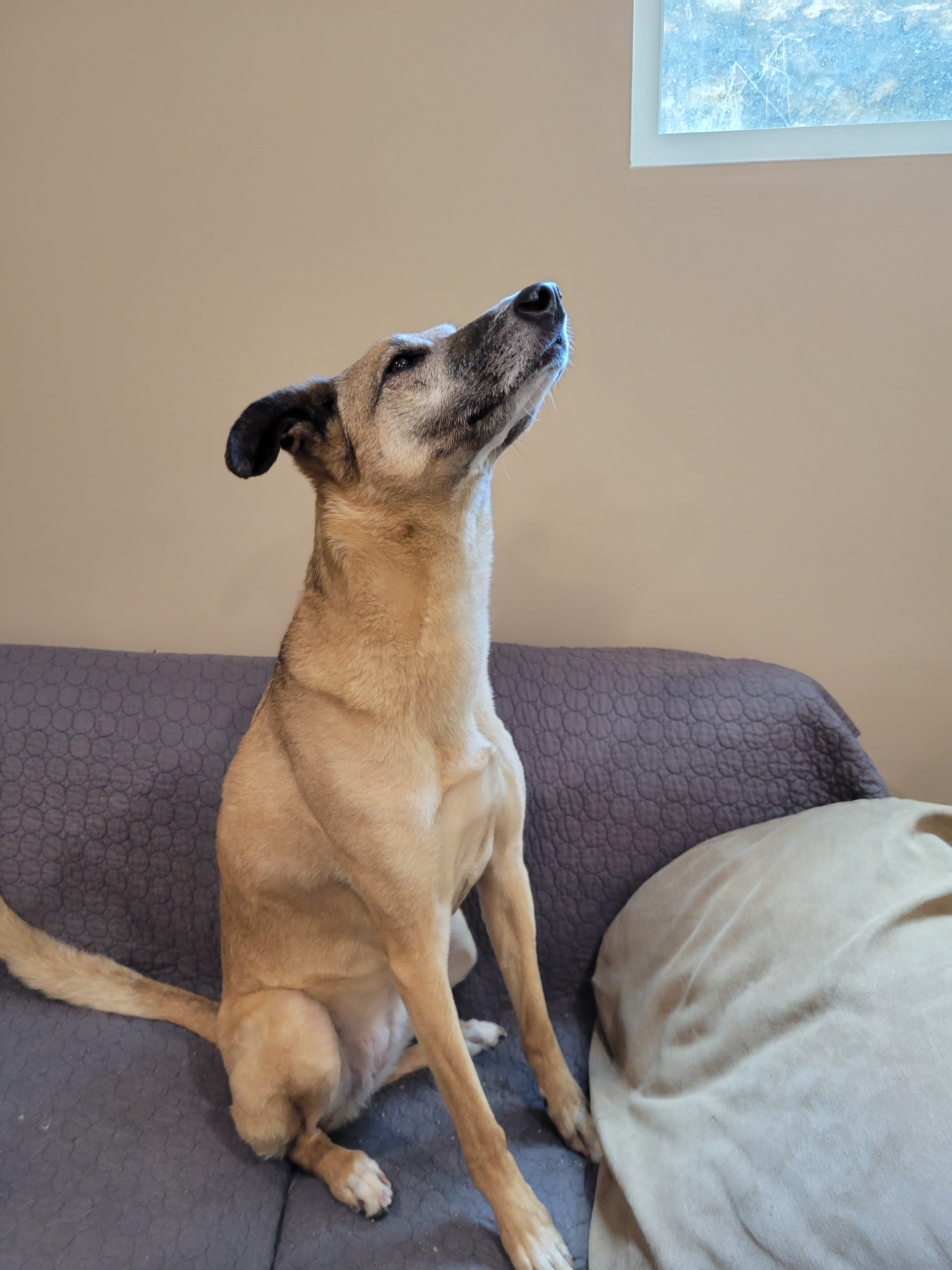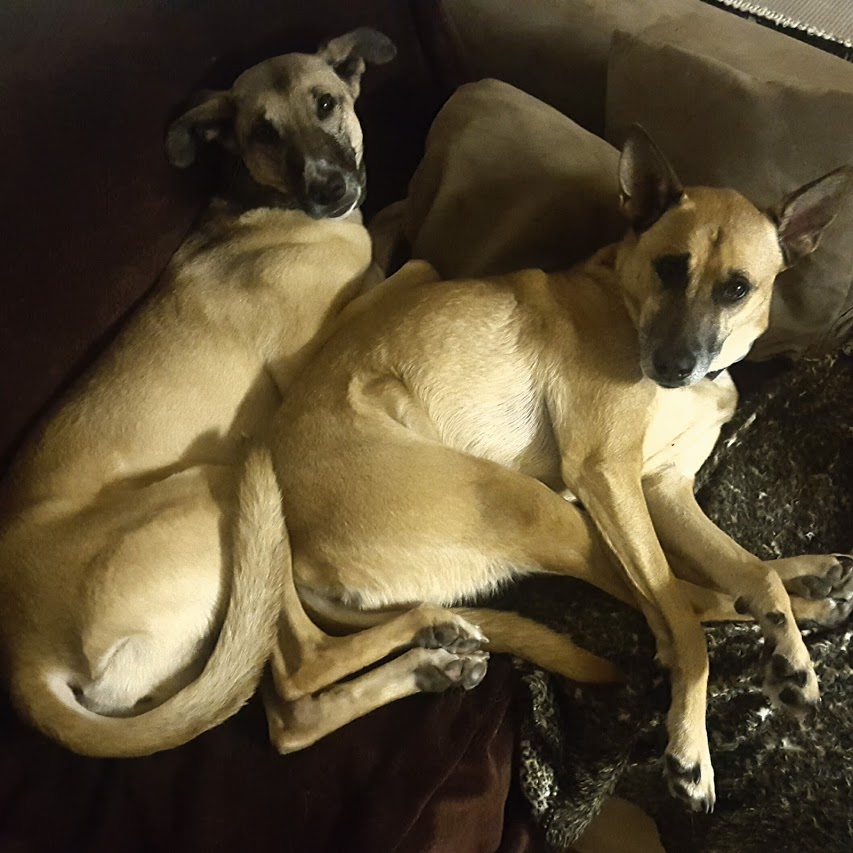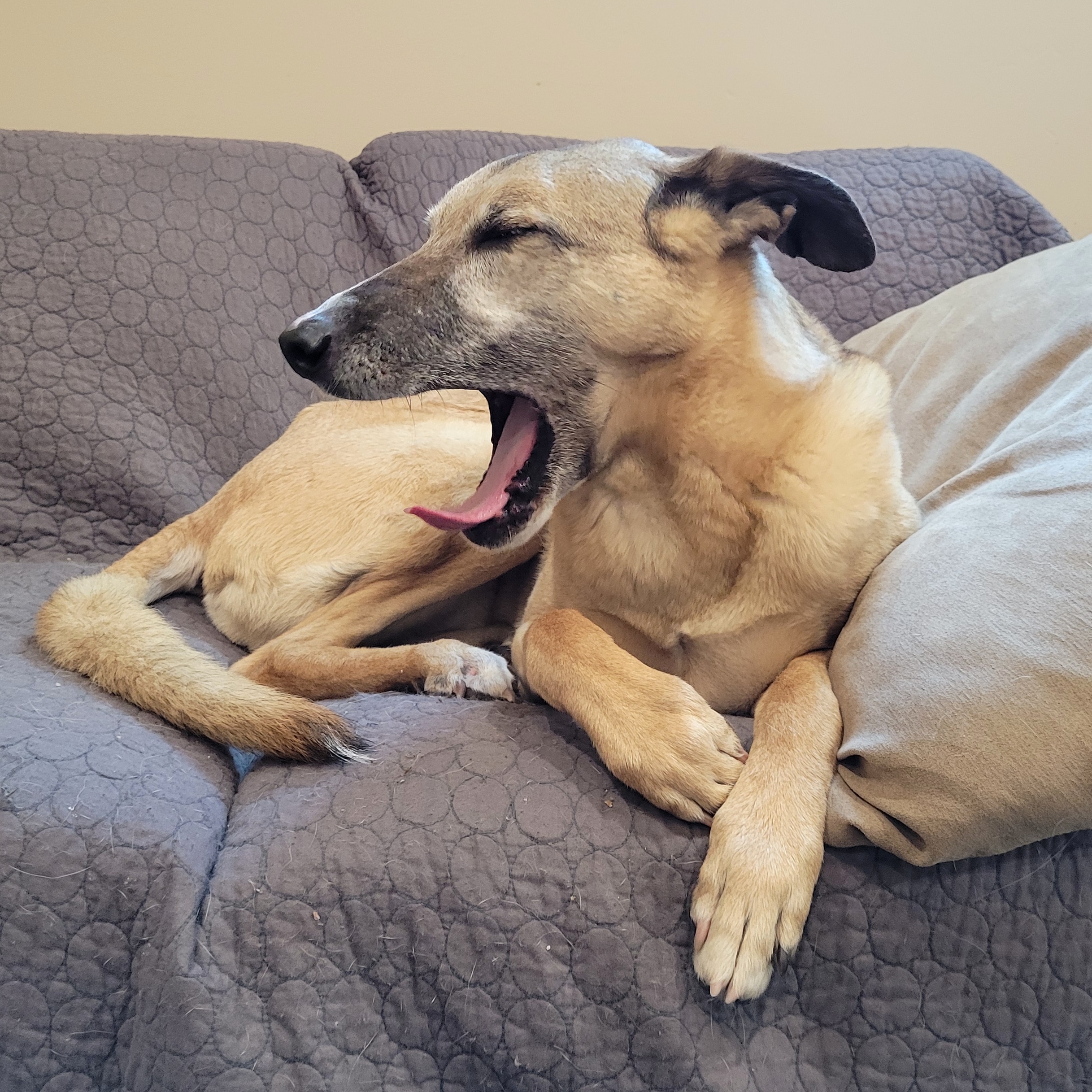I had several other things that I thought I was going to write about for this week’s blog post: more stuff on ego, some really interesting stuff I’ve been thinking about on frustration vs anticipation, and then a whole thing about plateaus in reactivity work that I’m really excited about.
But something got in the way: it was my walk on Tuesday.
One of the recent changes to my life is that I gifted myself with hiring a housekeeper to come twice a month to clean: I’m literally buying myself time by having someone else do my chores while I take the dogs out of the house for the time that she’s here. We try to find local hikes that are low-traffic for me & Kit (who, in case you’re just tuning in, is better-than-before but still WILDLY reactive to other dogs) and easy enough for 13 year old Shine and her functional-but-still-arthritic joints to manage. Because Stormy, my 10 year old, just had dental surgery on Monday, she needed to stay home, to have a fairly quiet morning while I took Kit and Shine out on a morning adventure.
We went to the park around 7:30 in the morning. Kit and I normally walk this park closer to 10:30 or 11 when most people are already done with their morning dog walks, but we figured it was early enough to be not too busy, and the trail has plenty of little offshoots if we needed more distance from other dogs.
Everything started off really well, Kit was in top form, and I don’t mean that in a snarky, sarcastic way: he was rocking it. We were able to work around the first dogs we saw, and he was playing the game like a champ. Honestly, he was much more interested in me and the game of “look-treats; look-at-mom-treats; look-treats” than he was interested in the dogs; my heart was swelling with pride in him and how far he’s come. Even when we passed by a group of women with a small (off leash!) dog, I was able to carry him past without incident.
Quick note: one of the things that Kit and I have worked on over the last few years is him letting me know when he needs to be picked up and carried. Unlike many dogs who find physical restraint incredibly stressful and aversive, when Kit is overwhelmed it has a decompressing effect on him. This is something I intend to write more about separately because it’s so cool and interesting. We have a fantastic system worked out where if I give him a cue like “touch” or “sit” but he is in too high a state of arousal to perform the behavior, he can place his front paws on me and I will pick him up because that’s the support he needs right then. If I think he’s getting a little stressed I can ask him, “Do you need an assist?” and if he does, he will place his front paws on me and I will pick him up and carry him; if he doesn’t hell look back at me and keep walking. Sometimes he asks me to pick him up without any cue or conversation before hand, he’s upset, and he knows he has the power to ask for what he needs. It’s a really lovely system, and I don’t know where we’d be without it. When I’m carrying him, I can feel his body going from rigid to slack in my arms as we walk along, and that’s when I know he’s ready to go back down: when all 30 pounds of him become deadweight instead of tense muscle. Again, I totally recognize how awesome this dialog between us is, and I’m excited to write more about it at a later date.
Back to the walk: Kit was doing really well. I had my treat bag pretty well loaded with two packets of cream cheese and a baggie full of my usual trail mix of cheese, hot dogs, and Happy Howie’s. It was a nice morning, cool, but with the promise of heat later on.
Anyway, it was really good. We would see dogs, and either work Kit where we were or I could move the kids away from the main trail far enough that I could work Kit and not have him anywhere near a point of reaction. Shine, who is a fearful girl, would also get treats for being in proximity with people and dogs, but her distance of concern is MUCH shorter, and she doesn’t hold onto stress the same way Kit does. So, Kit would get worked, Shine would get a cookie or two dropped on the ground for her. It was good. I was genuinely impressed by how well Kit was keeping it together, the choices he was making, and all those other wonderful things that dog reactive dog parents love to see from their kids.
As the morning crept along, we started seeing more and more dogs on the trail with their people, many of them off leash. Unfortunately, I had thought about what foot traffic was going to be like at 7:30 when we started, but not what foot traffic was going to be like as it got closer to 8:30 and then 9. That’s when people take their dogs for walks.
That’s when people with friendly dogs take their dogs for walks.
…and it felt like they were all heading on to the trail as we started getting closer to the end of the walk. Our first real problem happened when we were about two thirds through and a young woman on her cell phone was passing by with a white Pit mix. I think it probably would have been fine if that dog didn’t care about us, but that dog looked at us. It wasn’t threatening or even close to it, but the direct eye contact and pricked-forward ears were too much for my boy and Kit went over his edge into shrieking barks, lunging, and full amygdala overload. Nothing existed for him but that dog until we were able to get more distance from them, both spatially and temporally.
It wasn’t just that dog though. It was the fact that we had already passed several dogs. Trigger stacking is a real thing. If you’re not familiar with it (or choose not to watch the helpful video behind the link) the basic idea is that the stress-producing things that happen during our days pile up and compound. You don’t just spill your coffee, then stub your toe, then get cut off in traffic, and not have all of it affect how you react to the next stressor that pops up in an hour or so. We all, cross-species and individually, have different levels of ability to let things roll off, to not carry stressors or triggers with us through our hours and days. For humans, while chemicals still play a role, it’s a lot about how much we ruminate on the events and disturbances that have occurred. For dogs, I’m going to go out on a limb and assume it’s primarily chemical.*
Stress hormones like cortisol and adrenaline that get released into the system don’t just disappear when the event itself has ended, they stick around and have a residual effect on how the stressed individual reacts to things moving forward. When you have triggers stacking up, one after the other, without sufficient time between events for the chemicals to dissipate sufficiently to bring the dog back to baseline, you see arousal levels rise and rise and rise.
If that first dog we saw put Kit at a 4–because even though he didn’t display textbook reactivity, it was still a stressor–the next dog pushed him up to a 5. The one after that to a 6. You get it? Even though he was totally handling himself, there’s only so much he can take. Finally, that adorable Pittie pushed him over his limit, where he began barking like a maniac and was unable to cognitively engage in our training game.
I want to stop here and again acknowledge it was my own poor foresight that had us on the trail at a prime hour. I thought about the low traffic when we started, but not where things would be as we came back, and of course coming back means arriving at a trail head, the busiest part of the trail, after already experiencing all the stressors and stimuli of the whole walk.
That last half an hour of what should have been a much shorter walk, or I should say what could have been, consisted primarily of me jogging towards and then hiding in the bushes, either holding Kit or trying to keep his brain engaged, dodging poison oak, as well as trying to keep Kit out of it so I wouldn’t contract it from his coat when I had to pick him up.
He had a few over-the-edge moments that were, as far as I could see, unpreventable, and I was trying HARD to keep those moments to a minimum. At one point I literally climbed through scrubby bushes carrying Kit, and nearly dragging Shine to get away from an elderly woman with a cast on her leg and an off leash terrier. I was dropping treat crumbs on the ground for Shine while talking soothingly to Kit hoping this woman would pass quickly. She saw us in the bushes, and–of course!–stopped to ask if we needed help, when all I needed her to do was keep going.
At one point, a gentleman who we had passed previously on the loop stopped as I was hiding behind trees to try to talk to me about my dogs. His dog, a Cattle Dog mix, also off leash, was not helping the situation. I asked him to please just keep moving past us, or at least I hope that’s what I said.
In these meltdown moments he was no longer able to work and we weren’t able to get far enough away from the dogs to be able to keep him in a cognitive or functional state. All we could do was hope people walked fast and that their dogs were both on leash and uninterested in us.
I’m not sure I’m really clearly articulating just how horrible this was for me and Kit. When we were probably a quarter mile from the end we were stuck hanging out maybe 30-40′ off the trail just waiting for dog after dog to pass. I was running low on treats and he was up so high he wasn’t fully engaged anyway. At one point we thought the coast was clear and I started back up towards the trail and all of a sudden there was a woman with a stroller and a retriever just a few yards away. Kit lost it again and we had to turn back into our hiding spot. At some point I even lost the first packet of cream cheese that I opened up.**
This probably reads like the overly dramatic comedy version of what most reactive dog parents deal with all the time. It’s funny because it’s true.
One of the saving graces of the situation is that we had no real options, so there was no internal struggle. All we could do was keep dancing this dance: on the trail, off the trail, on the trail, off the trail. I accepted the moment we were in.
There was one option that only occurred to me in dark jest during one of our extended rest stops in the bushes: just stay on the trail and keep going. Let Kit blow up to get to the car sooner.
…And I did want to get back to the car. More than anything, I just wanted this horrible horrible walk to be over. I wanted to get back to my car which is clearly labeled by the large magnets stuck to the doors to belong to a dog trainer. So anyone who saw me and my dogs would know exactly who not to call for help with their own problematic pups. Insert face-palm emoji here.
I’ve been listening to a lot of Tara Brach, a wonderful Buddhist meditation teacher lately. Anyone familiar with her knows that she talks at great length and with great insight about compassion. Compassion for oneself and compassion for others. I think that was what inspired me to, at one moment as we were crouched in the bushes, to whisper to kit, over and over again, I love you, I love you.
I think it was the most important thing I did during that whole walk.
Because I love him.
I’m hiding in the bushes, dropping packets of cream cheese, dodging poison oak, and and bending so much of my life around his needs.
Because I love him.
I’m not dragging him out on the trail to pass other dogs, just to get over it with, because I love him. Because I don’t want him to experience all the upset that’s so obvious when we’re too close to another dog.
I want him to live as calm and peaceful a life as possible, and that means going out of my way to protect him from the things that cause him so much distress that he will turn into a screaming demon.
In my last post, I talked about the shame that I so often feel when Kit reacts. But I didn’t feel that at all on Tuesday: I felt concern and care and compassion. I just wanted him to feel okay.
Yes, I was frustrated that things went so south at the end of what started off as a beautiful and successful walk, but I wasn’t frustrated at Kit, and I wasn’t frustrated at myself. I had moments of frustration at the people who stopped to talk with us, although I know that they were just showing compassion for us in their own way: wanting to make sure we were okay, trying to see if there was anything we needed that they could help us with. If they had ever had reactive dogs, they would have known what I needed was the exact opposite of what they chose to do, but I can’t fault them for never having a dog like Kit. I wasn’t angry with them. I certainly wasn’t blaming them for my dog’s behavior.
But I also wasn’t blaming my dog for my dog’s behavior.
It’s just behavior.
It’s the result of neurons firing & chemicals releasing as a response to an external stimulus.
I am not mad at my dog for his brain.
I love my dog for his brain.
I love my dog.
I love my dog.
And I say to my dog: I love you. I love you. I love you.
Even when it’s hard.
And especially when it’s hard.
We got back to the car eventually.
Sitting on a bench not too far from us was the gentleman with the Cattle Dog mix who had tried to talk to me earlier. I put Shine and Kit in the car and then went down to chat with him. I started off by apologizing if I came off as snappy earlier, and he said he just wanted to see if my dog was so excited because he was friendly and wanted to say hello. I laughed and let him know that that wasn’t the case, that that Kit was not friendly. I explained that I normally take this trail at a different time, that I was not anticipating quite so many dogs. We chatted for a few moments, he told me about his daughter, who is a groomer, which explained why his mostly-white dog had large dyed orange stripes on her coat that were reminiscent of a tiger. He said she had entered a contest. We said our goodbyes, I excused myself back to my car, and I drove home.
Back at home, the housekeeper was just finishing up. She told me that Stormy hadn’t barked at her at all, and while she wouldn’t take treats from her hand, Stormy would eat the ones that she tossed on the floor. Not barking and eating treats is a success in our book.
Kit and Shine drank water, cooled off on the clean floor, and took long naps after they settled down from the excitement of the morning. I showered and settled in for my day of desk work, and was surprised by how calm I felt after so much difficulty and upset on our walk.
While I wasn’t protected from unpleasant emotions on our walk, I was protected from destructive emotional aftershocks and thought cycles because–I think–blame and shame never entered the story. There was concern, fear, distress, and frustration, but I wasn’t throwing the fault of all those feelings on Kit, myself, or the dog walkers we passed. I focused my heart and my actions on the most important thing: shielding Kit from what upsets him, and by protecting him, I protected myself.

* I highly doubt that Kit spends much time thinking about those two retrievers who bark at him from behind their fence hours after we’ve already passed the house. Just a guess, though.
**My apologies to the person who found it later and probably silently condemned the thoughtless person who dropped it on the trail.




